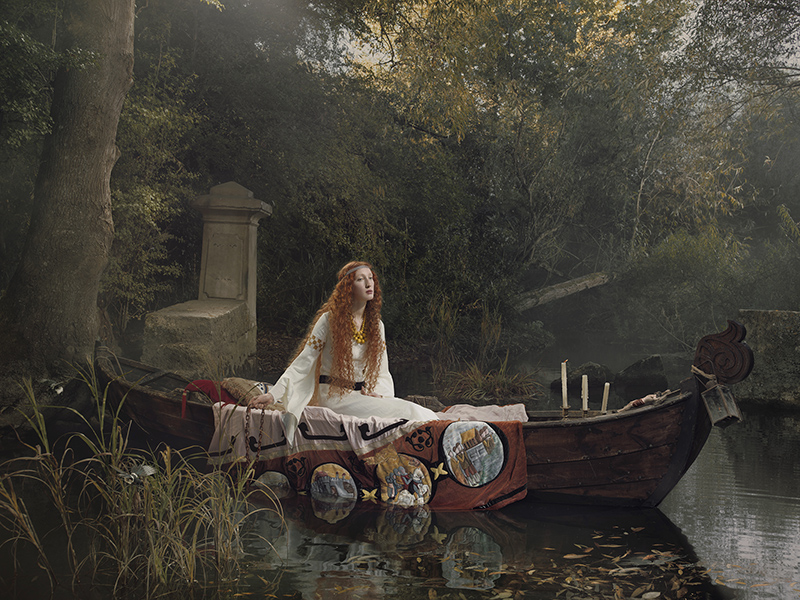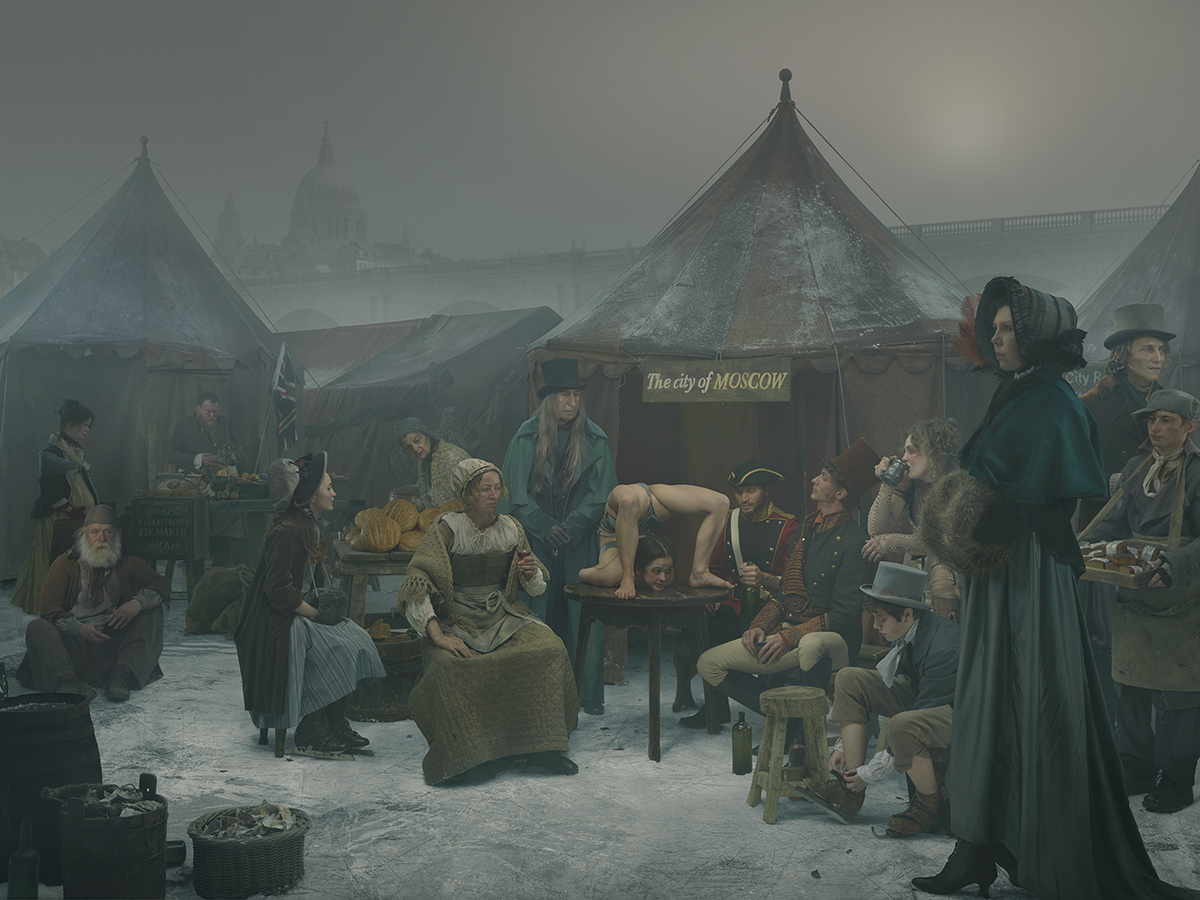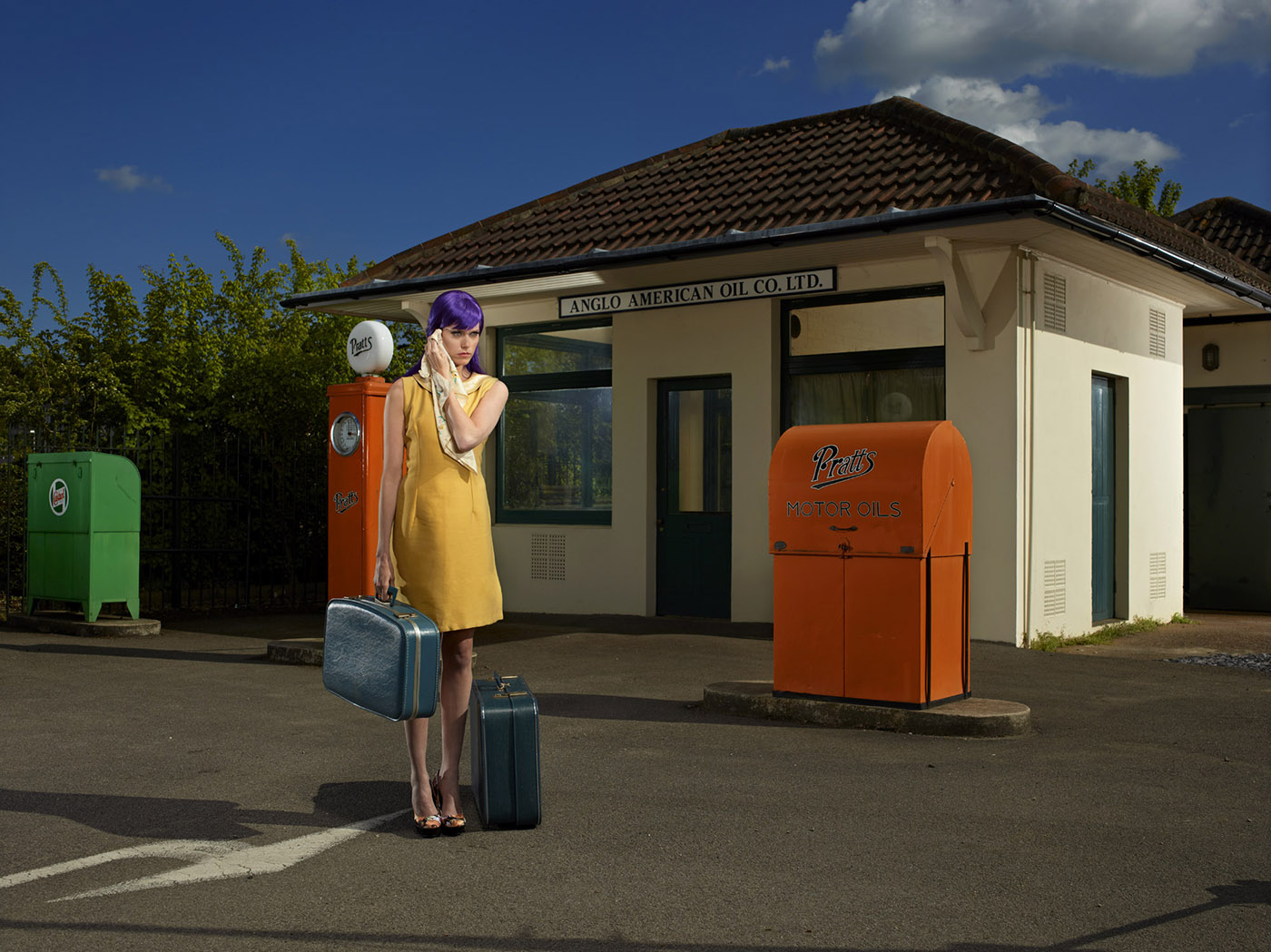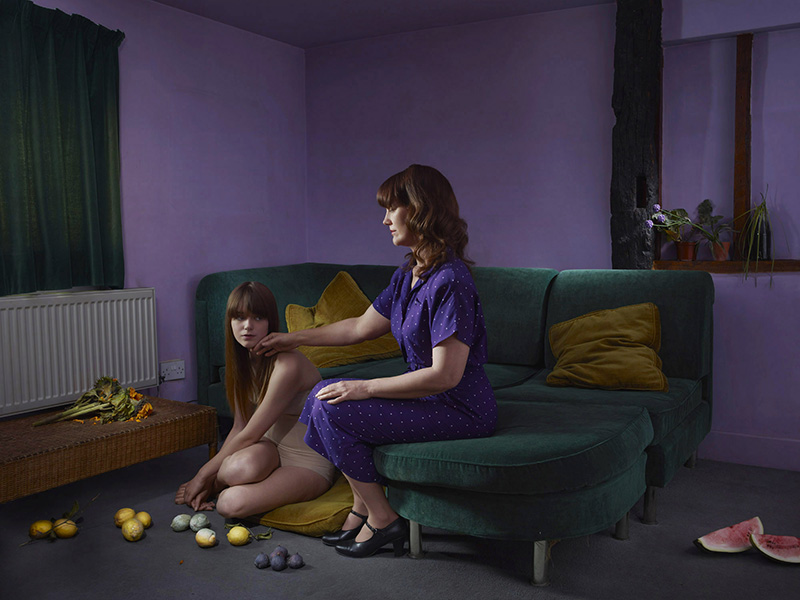Art photographer Julia Fullerton-Batten says it is all about balancing one’s personal creative output with the cut and thrust of commercial shoots
I often start with a small seed of an idea in my head. This small idea evolves and before I go full steam into it, I need to make sure I am going to commit to it fully. Projects can take anything from a year to three years to create. I have to be fully confident before I go steaming ahead, because once I commit to a project I dive in deep and live with the subject matter on a daily basis.
Art photographer Julia Fullerton-Batten

Artist portrait. Art photographer Julia Fullerton-Batten.
How did your tryst with art begin?
The beginning of my story started before I was even born. It happened when my parents had their first child and my father decided to capture their lives on film. His fatherly love turned soon into a hobby and he enthralled me and my siblings with the images that he produced, both of our family and the world around him. Years later I borrowed one of his cameras and made it mine. When the time came in my mid-teens to decide what career path I wished to take, there was only one – to become a photographer.
I was the second of four children in Germany. My father’s work took us to the USA, then back to Germany, before my parents’ divorce led to us moving to the UK where, after finishing my secondary education, I studied photography. After graduating I was a freelance assistant to professional photographers working in many different fields. For five long years, competing with male assistants for jobs, I learned practical skills and began to hone my own style.
How to be a photographer.
At the same time I was constantly updating my portfolio and entering competitions. Once a year I would make long trips abroad taking my camera with me. My last such trip was to Vietnam and it pushed my career as a photography assistant. As usual I entered several images in competitions and was fortunate to win a number of awards. A German agent noticed this and represented me. Within a short time the agency won a major assignment for me. I was able to exploit all my skill sets learned and developed over all those years. That was the start of my professional career.
I soon became a successful commercial photographer but always had a yearning to shoot my own projects as a fine-art photographer. I started in a small way with small projects hiring street-cast models and shooting mostly on location. The first project I completed, Teenage Stories, was in 2005. It was semi-autobiographical in nature detailing episodes that I still recollected from my own years as a teenager making the gradual transition to womanhood. The project was exceedingly well received and won an award, which resulted in the publication of my first book. I also got a commission from the National Portrait Gallery in London to photograph portraits of sixteen leading people in the UK health service, which after being exhibited in the gallery for six months are now permanently stored in the archives.
In consonance with my family relationships, I have taken on a number of other projects related to more social aspects, among others blindness, figure consciousness, feral children, women’s voluntary engagement in the adult industry, the treatment of servants during the Edwardian era, and so on. I am now completing the first stage of my largest and probably most significant project to-date, which is Old Father Thames. It captures the history, traditions and customs along the length of the River Thames from its source to its estuary to the North Sea.

Lady of Shalott. Julia Fullerton-Batten.
What is the primary role of an artist? How do you describe yourself in the context of challenging people’s perspectives via your work and art?
I am a story-teller with my fine-art photography. I turn an initial idea into a series of individual images each portraying in detail the essence of that idea. Using locations, settings, actors, props, styling, lighting to weave these stories into a pictorial image, I hope will ask the viewer questions as to their interpretation of the subject matter. I hope to both inspire and provoke them with the content of the images.
How do you deal with the conceptual difficulty and uncertainty of creating work?
I often start with a small seed of an idea in my head. This small idea evolves and before I go full steam into it, I need to make sure I am going to commit to it fully. Projects can take anything from a year to three years to create. I have to be fully confident before I go steaming ahead, because once I commit to a project I dive in deep and live with the subject matter on a daily basis. All of my projects are large scale – from the idea to the production to the actual shoot. They are very detailed and comprise 12 to over 20 images. I always have many ideas flowing in my head, but there is always the ‘one’ that I connect with, making sure that I love it enough before I start.
A fine-art photographer, indeed anybody engaged in any form of art work, produces their work for a number of reasons – ranging from it being the raison d’etre of their life to it being a material necessity. I have always approached my ideas that end up as my fine-art creations as something that I want to do and also because I wish to make my opinions felt.

1814 Frost Fair – Contortionist. Julia Fullerton-Batten.
What about the evolution of your practice over the years? Tell us about your commitment to your current medium.
I equate the evolution of my practice and work to be similar to the transition from childhood to adulthood. Over the years I have honed my style and the techniques that I use, the subject matter of the projects that I shoot, have become more expansive and more provocative, and the projects themselves have become larger to produce. It has matured. It has been a progressive development and I’m sure that it will continue that way. However, I did enjoy directing a film called 1814 Frost Fair, my latest project, so I may end up doing more of that.
Let’s talk about your career. What were your biggest lessons and hurdles?
My five years as an assistant were not easy by any stretch of the imagination but the learning on the job was in the end very rewarding, both the good and the bad times. I not only learned skills and techniques, but also developed a business sense, which has held me in good stead through the years.
A big regret that I do have is that earlier in my career I turned down many opportunities to be a speaker at important photography events. My fear of speaking held me back, until I decided one day I would just do it and say yes to nearly every request I could. I have met many interesting people and made many friends as a result of taking on that challenge.
Also, I didn’t always go to some of my own exhibitions as I had young children and travelling wasn’t easy. I manage to do this more now that they are older. But I am conscious that there were many missed opportunities that I now see were important to have attended.

Testament – The Lonely Road. Julia Fullerton-Batten.
What is your experience of the power of formative collaborations? Which residency, curator or gallery helped you on your artistic journey?
Wish I had more help earlier on. I see nowadays so many forums that help young female artists get started in their careers. I started my career before the advent of digital and internet. Back then it was hard for me to promote myself, but nowadays social media can help get a budding artist get recognised more quickly.
Having a gallery was and still is essential for my exhibitions, art sales and museum showings but, again, I am still striving to find a gallery with which I can collaborate in depth.
Let’s talk about your frameworks, references and process. What inspires you?
My photographic style encompasses cinematic lighting, powerful colour combinations, careful choice of models and the use of settings and props which enhance the visual story. I continually study the works of painters of all eras, for instance Edward Hopper is a particular favourite, and cinema and television, and the life around me for inspiration.

Testament – The End Of The Affair. Julia Fullerton-Batten.
What are you looking for when you look at other artists’ work?
A lot of my inspiration comes from art in general, from painters, sculptors, film directors, television, theatre and other photographers, both contemporary and from the older era. I am now asked to judge international photographic competitions, so I see and evaluate a lot of work. Instinctively, I know when I like another artist’s work, but only occasionally will I attempt to analyse it to the extent that I could give a written description of the reasons why.
Visiting museums and galleries, and I have a considerable library of other photographers’ books. I follow many fellow artists of all sorts on social media. I appreciate watching movies and, quite often, find myself considering a still from the film because it particularly appeals to me. Then, of course, I tend to lose track of the content of the film.
Which shows, performances and experiences have shaped your own creative process? Who would you like to read about?
I am not necessarily a hero worshipper and, sometimes, will follow or fall out with somebody’s work. So my current flavour of the month might not be the same the next month.
As to whose journey I would currently like to read about would be that of Jeff Wall. I have always been a huge admirer of his work and really appreciate the way he creates his scenes. I would love to be with him on set and just watch him work. You never know if the locations are real or have been built. He once said, “Not photographing gives me imaginative freedom that is crucial to the making of art. That, in fact, is what art is about – the freedom to do what you want’.
How do you balance art and life?
Art and life go together. I am inspired when walking with my kids at low tide on the banks of the river Thames, which is, in fact, where I first got the idea for Old Father Thames. When the boys were babies, I would spend many nights breastfeeding and dreaming of new ideas.
What was your first sale? Do you handle the commercials yourself or is it outsourced to a gallery or agent?
My first sale was a print entitled Elliot. I set up a shoot with my neighbours’ son on a London bus. I bought a goldfish in a plastic bag with water and we carried it on to the bus. The image is of his legs with the goldfish on the floor next to him. Since then I have included a shot of a goldfish in various other projects.
My first solo show was at the Photographers Gallery in Notting Hill, London. The director of the gallery bought the print. He was also the photography critic at the Financial Times and head of Sotheby’s photography department. The print still hangs on a wall in his home.

M&D – The Divorce. Julia Fullerton-Batten.
Let’s talk about Duality. Artists often experience contradicting motivations – commercial versus creative. How do you strike a balance?
To be creative is the motivating element. To be commercial is the necessary outcome of sustaining an existence. I am first and foremost a creative photographer, but I enjoy the cut and thrust of a commercial assignment
How does your interaction with a curator, gallery or client evolve?
The interaction depends on the degree of involvement or engagement. For example, some galleries show my work more regularly than others, but the relationship is generally long term. I have been with my galleries for many years and we stay loyal to one another.
However, the relationship with a commercial client, although intense, is generally shorter and more fleeting.
Are you more of a studio artist or naturally collaborative by nature? How do you feel about commissions?
I am very collaborative in nature. I enjoy having a good balance of work, for both my fine-art projects and commission work. Increasingly, I have found that I win commissions because my fine-art work is appreciated and suits the brief. As a consequence, my input regarding various aspects of a commission assignment is appreciated, from recommending, choosing and sourcing actors, locations, also decisions on lighting, colours, clothing, poses, design and construction of sets and so on.
The collaborative nature of a commission shoot is often very welcome and relaxing compared with a fine-art shoot, where the onus is on my shoulders entirely.

Bedroom model, Julia Fullerton-Batten.
How does your audience interact and react to your work?
The response in China, a trip I went on recently, was overwhelming. People always seem curious to find out how I created the look and feel in my images.
What are you working on now? What’s coming next season?
My Old Father Thames project has absorbed my attention for the past three and a half years and could become a life-long project, as there are so many more ideas to be shot. I will soon publish the film from my last shoot, 1814 Frost Fair.
I am currently thinking of taking a break from this mammoth project and shoot something else in between, but I’m not sure what it will be yet.
Before you go – you might like to browse our Artist Interviews. Interviews of artists and outliers on how to be an artist. Contemporary artists on the source of their creative inspiration.











Add Comment